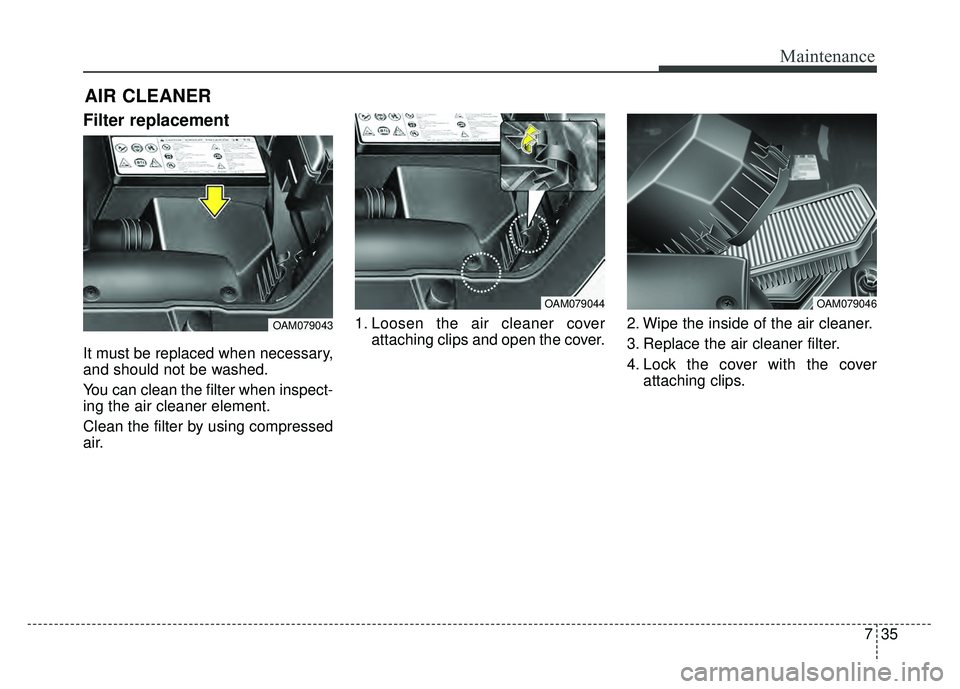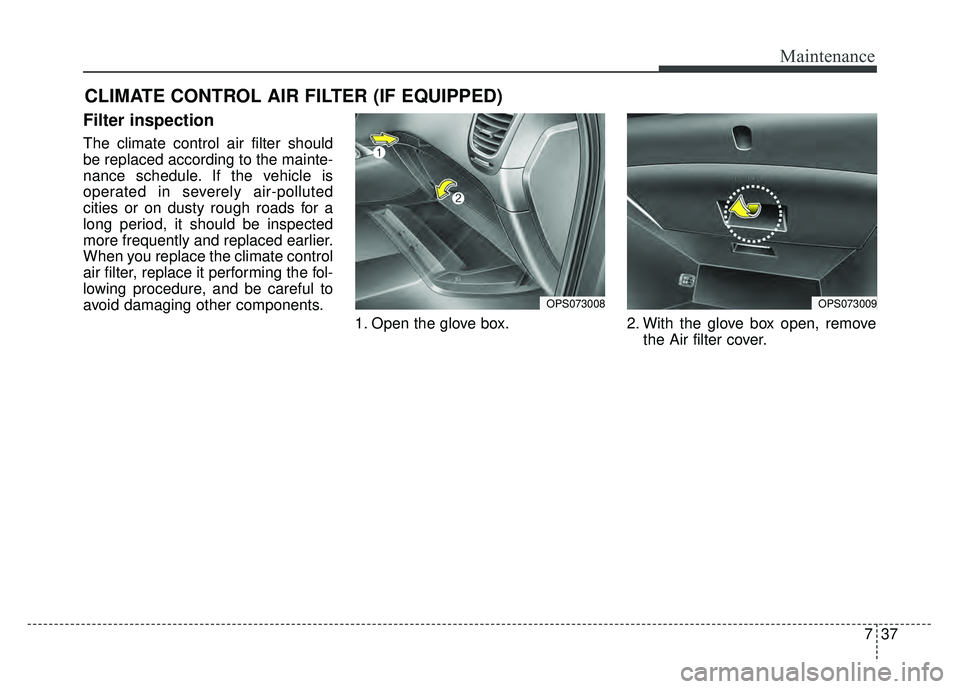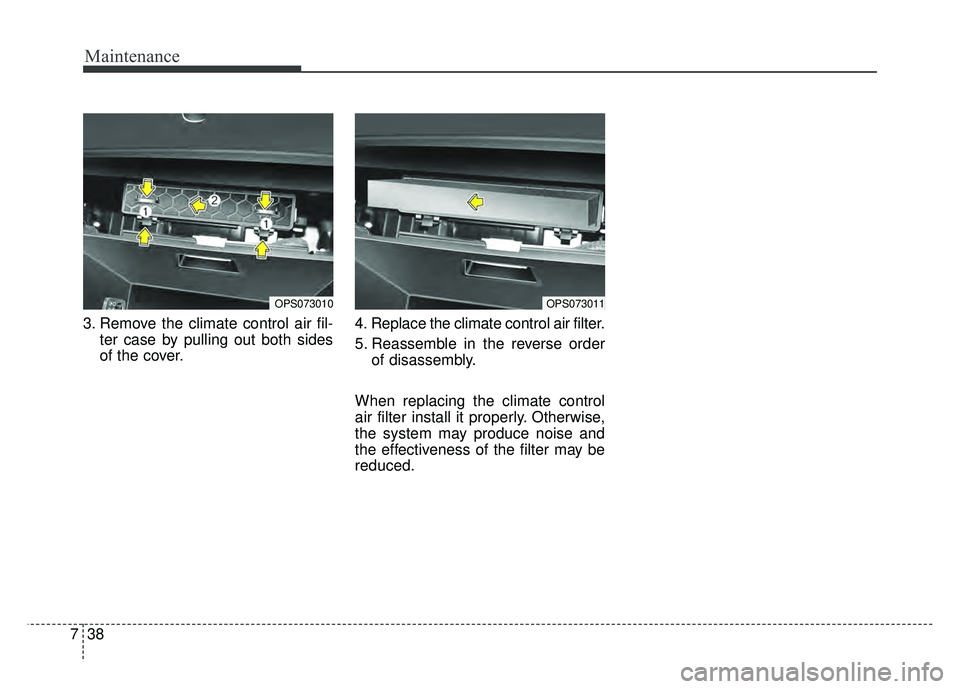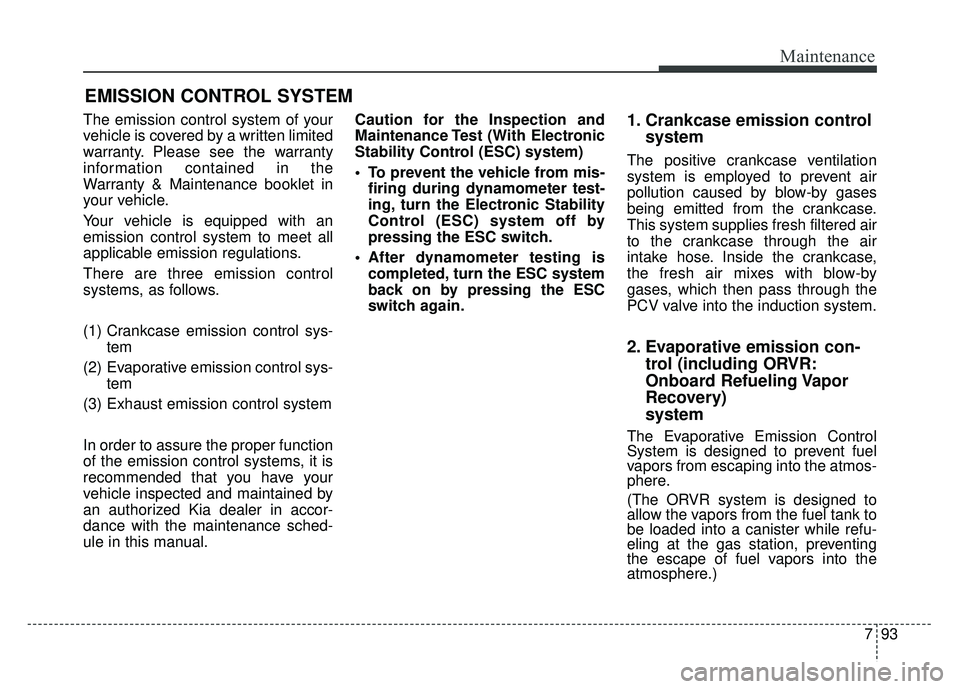2015 KIA SOUL air filter
[x] Cancel search: air filterPage 442 of 544

Maintenance
22
7
MAINTENANCE UNDER SEVERE USAGE CONDITIONS
The following items must be serviced more frequently on cars normally used under severe driving conditions. Refer
to the chart below for the appropriate maintenance intervals.
R : Replace I : Inspect and, after inspection, clean, adjust, repair or replace if neces\
sary
R
R
R
I
I
I
I
R
R
R EVERY 3,750 miles OR 6 months
MORE FREQUENTLY
MORE FREQUENTLY
MORE FREQUENTLY
MORE FREQUENTLY
MORE FREQUENTLY
EVERY 7,500 miles OR 6 months
EVERY 80,000 miles
EVERY 60,000 miles
MORE FREQUENTLYA, B, C, D, E, F, G, H, I, J, K
C, E
A, B, H, I, K
C, D, G, H
C, D, G, H
C, D, E, F, G, H, I
C, D, E, F, G, H
A, C, D, E, F, G, H, I, J
A, C, E, F, G, H, I
C, EENGINE OIL AND FILTER
AIR CLEANER FILTER
SPARK PLUGS
DISC BRAKE/ PADS, CALIPERS AND ROTORS
REAR BRAKE DRUMS/ LININGS, PARKING BRAKE
STEERING GEAR BOX, LINKAGE & BOOTS/ LOWER
ARM BALL JOINT, UPPER ARM BSALL JOINT
DRIVE SHAFTS AND BOOTS
MANUAL TRANSAXLE OIL
AUTOMATIC TRANSAXLE FLUID
CLIMATE CONTROL AIR FILTER
(FOR EVAPORATOR AND BLOWER UNIT)
MAINTENANCE ITEM
MAINTENANCE
OPERATION MAINTENANCE
INTERVALS DRIVING
CONDITION
SEVERE DRIVING CONDITIONS
A - Repeatedly driving shorts distanse of less than 5miles in normal temperature or less than 10miles in freezing temperature
B - Extensive engine idling or low speed driving for long distances
C - Driving on rough, dusty, muddy, unpaved, graveled or salt-spread roads
D - Driving in areas using salt or other corrosive materials or in very cold weather E - Driving in sandy areas
F - Driving in heavy traffic area over 90°F (32°C)
G - Driving on uphill, downhill, or mountain road
H - Towing a Trailer, or using a camper, or roof rack
I - Driving as a patrol car, taxi, other commercial use or vehicle towing
J - Driving over 100 MPH
K - Frequently driving in stop-and-go conditions
Page 444 of 544

Maintenance
24
7
Vacuum crankcase ventilation
hoses (if equipped)
Inspect the surface of hoses for evi-
dence of heat and/or mechanical
damage. Hard and brittle rubber,
cracking, tears, cuts, abrasions, and
excessive swelling indicate deterio-
ration. Particular attention should be
paid to examine those hose surfaces
nearest to high heat sources, such
as the exhaust manifold.
Inspect the hose routing to assure
that the hoses do not come in con-
tact with any heat source, sharp
edges or moving components which
might cause heat damage or
mechanical wear. Inspect all hose
connections, such as clamps and
couplings, to make sure they are
secure, and that no leaks are pres-
ent. Hoses should be replaced
immediately if there is any evidence
of deterioration or damage.
Air cleaner filter
A Genuine Kia air cleaner filter is
recommended when the filter is
replaced.
Spark plugs
Make sure to install new spark plugs
of the correct heat range.
Valve clearance (if equipped)
Inspect for excessive valve noise
and/or engine vibration and adjust if
necessary. An authorized Kia dealer
should perform the operation.
Cooling system
Check the cooling system compo-
nents, such as the radiator, coolant
reservoir, hoses and connections for
leakage and damage. Replace any
damaged parts.
Coolant
The coolant should be changed at
the intervals specified in the mainte-
nance schedule.
Page 455 of 544

735
Maintenance
Filter replacement
It must be replaced when necessary,
and should not be washed.
You can clean the filter when inspect-
ing the air cleaner element.
Clean the filter by using compressed
air.1. Loosen the air cleaner cover
attaching clips and open the cover. 2. Wipe the inside of the air cleaner.
3. Replace the air cleaner filter.
4. Lock the cover with the cover
attaching clips.
AIR CLEANER
OAM079043
OAM079044OAM079046
Page 456 of 544

Maintenance
36
7
Replace the filter according to the
Maintenance Schedule.
If the vehicle is operated in extreme-
ly dusty or sandy areas, replace the
element more often than the usual
recommended intervals. (Refer to
“Maintenance under severe usage
conditions” in this chapter.)CAUTION- Air filter main-
tenance
Do not drive with the air clean- er removed; this will result inexcessive engine wear.
When removing the air cleaner filter, be careful that dust ordirt does not enter the airintake, or damage may result.
Use a Kia genuine part. Use of non-genuine parts could dam-age the air flow sensor.
Page 457 of 544

737
Maintenance
CLIMATE CONTROL AIR FILTER (IF EQUIPPED)
Filter inspection
The climate control air filter should
be replaced according to the mainte-
nance schedule. If the vehicle is
operated in severely air-polluted
cities or on dusty rough roads for a
long period, it should be inspected
more frequently and replaced earlier.
When you replace the climate control
air filter, replace it performing the fol-
lowing procedure, and be careful to
avoid damaging other components.1. Open the glove box. 2. With the glove box open, remove the Air filter cover.
OPS073009OPS073008
Page 458 of 544

Maintenance
38
7
3. Remove the climate control air fil-
ter case by pulling out both sides
of the cover. 4. Replace the climate control air filter.
5. Reassemble in the reverse order
of disassembly.
When replacing the climate control
air filter install it properly. Otherwise,
the system may produce noise and
the effectiveness of the filter may be
reduced.
OPS073010OPS073011
Page 513 of 544

793
Maintenance
EMISSION CONTROL SYSTEM
The emission control system of your
vehicle is covered by a written limited
warranty. Please see the warranty
information contained in the
Warranty & Maintenance booklet in
your vehicle.
Your vehicle is equipped with an
emission control system to meet all
applicable emission regulations.
There are three emission control
systems, as follows.
(1) Crankcase emission control sys-tem
(2) Evaporative emission control sys- tem
(3) Exhaust emission control system
In order to assure the proper function
of the emission control systems, it is
recommended that you have your
vehicle inspected and maintained by
an authorized Kia dealer in accor-
dance with the maintenance sched-
ule in this manual. Caution for the Inspection and
Maintenance Test (With Electronic
Stability Control (ESC) system)
To prevent the vehicle from mis-
firing during dynamometer test-
ing, turn the Electronic Stability
Control (ESC) system off by
pressing the ESC switch.
After dynamometer testing is completed, turn the ESC system
back on by pressing the ESC
switch again.1. Crankcase emission control system
The positive crankcase ventilation
system is employed to prevent air
pollution caused by blow-by gases
being emitted from the crankcase.
This system supplies fresh filtered air
to the crankcase through the air
intake hose. Inside the crankcase,
the fresh air mixes with blow-by
gases, which then pass through the
PCV valve into the induction system.
2. Evaporative emission con-trol (including ORVR:
Onboard Refueling Vapor
Recovery)
system
The Evaporative Emission Control
System is designed to prevent fuel
vapors from escaping into the atmos-
phere.
(The ORVR system is designed to
allow the vapors from the fuel tank to
be loaded into a canister while refu-
eling at the gas station, preventing
the escape of fuel vapors into the
atmosphere.)
Page 533 of 544

Index
2I
A/V Mode . . . . . . . . . . . . . . . . . . . . . . . . . . . . . . . . . . . 4-\
62
Active ECO system. . . . . . . . . . . . . . . . . . . . . . . . . . . . 5-42Active ECO operation . . . . . . . . . . . . . . . . . . . . . . . 5-42
Limitation of Active ECO operation . . . . . . . . . . . . 5-42
When Active ECO is activated . . . . . . . . . . . . . . . . . 5-42
Air bag collision sensors . . . . . . . . . . . . . . . . . . . . . . . 3-54
Air bag inflation conditions . . . . . . . . . . . . . . . . . . . . . 3-54
Air bag operation . . . . . . . . . . . . . . . . . . . . . . . . . . . . . 3-38
Air bag warning label . . . . . . . . . . . . . . . . . . . . . . . . . . 3-60
Air bag warning light . . . . . . . . . . . . . . . . . . . . . . . . . . 3-40
Air bags. . . . . . . . . . . . . . . . . . . . . . . . . . . . . . . . . . . . \
. 3-37 Air bag collision sensors . . . . . . . . . . . . . . . . . . . . . 3-54
Air bag inflation conditions . . . . . . . . . . . . . . . . . . . 3-54
Air bag warning label. . . . . . . . . . . . . . . . . . . . . . . . 3-60
Air bag warning light . . . . . . . . . . . . . . . . . . . . . . . . 3-40
Curtain air bag . . . . . . . . . . . . . . . . . . . . . . . . . . . . . 3-53
Driver's and passenger's front air bag . . . . . . . . . . . 3-49
Occupant Detection System (ODS) . . . . . . . . . . . . . 3-44
Operation . . . . . . . . . . . . . . . . . . . . . . . . . . . . . . . . . 3-38
Side air bag. . . . . . . . . . . . . . . . . . . . . . . . . . . . . . . . 3-52
SRS components and functions . . . . . . . . . . . . . . . . 3-41
Air cleaner . . . . . . . . . . . . . . . . . . . . . . . . . . . . . . . . . . 7-35\
Air Conditioning refrigerant label . . . . . . . . . . . . 4-109,122
Airconditioning system . . . . . . . . . . . . . . . . . . . . 4-100,110 Automatic climate control system . . . . . . . . . . . . . 4-110
Manual climate control system . . . . . . . . . . . . . . . 4-100 Antenna . . . . . . . . . . . . . . . . . . . . . . . . . . . . . . . . . . . . \
4-143
Anti-lock brake system (ABS) . . . . . . . . . . . . . . . . . . . 5-27
Appearance care . . . . . . . . . . . . . . . . . . . . . . . . . . . . . . 7-86
Exterior care . . . . . . . . . . . . . . . . . . . . . . . . . . . . . . . 7-86
Interior care . . . . . . . . . . . . . . . . . . . . . . . . . . . . . . . 7-91
Armrest (rear) . . . . . . . . . . . . . . . . . . . . . . . . . . . . . . . . 3-15
Audio remote control . . . . . . . . . . . . . . . . . . . . . . . . . 4-144
Audio system . . . . . . . . . . . . . . . . . . . . . . . . . . . . . . . 4-143 Antenna . . . . . . . . . . . . . . . . . . . . . . . . . . . . . . . . . 4-143
Audio remote control . . . . . . . . . . . . . . . . . . . . . . . 4-144
Aux, USB and iPod
®port . . . . . . . . . . . . . . . . . . . 4-145
Speaker lightings . . . . . . . . . . . . . . . . . . . . . . . . . . 4-146
Auto light position . . . . . . . . . . . . . . . . . . . . . . . . . . . . 4-87
Auto start . . . . . . . . . . . . . . . . . . . . . . . . . . . . . . . . . . . 5-\
44
Auto stop. . . . . . . . . . . . . . . . . . . . . . . . . . . . . . . . . . . . \
5-43
Automatic climate control system . . . . . . . . . . . . . . . 4-110 Air Conditioning refrigerant label . . . . . . . . . . . . . 4-122
Automatic heating and air conditioning. . . . . . . . . 4-111
Checking the amount of air conditioner refrigerantand compressor lubricant . . . . . . . . . . . . . . . . . . . 4-121
Climate control air filter. . . . . . . . . . . . . . . . . . . . . 4-120
Manual heating and air conditioning . . . . . . . . . . . 4-112
System operation . . . . . . . . . . . . . . . . . . . . . . . . . . 4-118
Automatic transaxle . . . . . . . . . . . . . . . . . . . . . . . . . . . 5-17 Automatic transaxle operation . . . . . . . . . . . . . . . . . 5-17
Good driving practices . . . . . . . . . . . . . . . . . . . . . . . 5-22
Ignition key interlock system . . . . . . . . . . . . . . . . . . 5-22
Shift lock system . . . . . . . . . . . . . . . . . . . . . . . . . . . 5-21
A